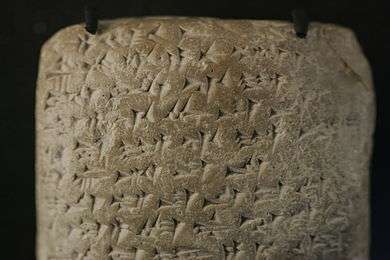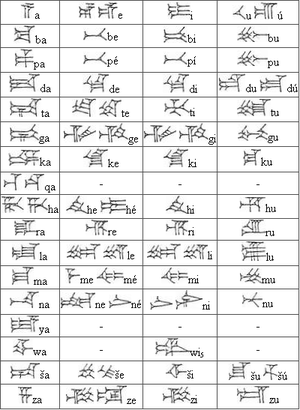Ki (cuneiform)

Usage in Line 7, last (visible)-character in line; text reads left-to-right.
(high resolution, expandible photo)
| Wikimedia Commons has media related to Ki (cuneiform). |
The cuneiform ki sign, is a multi-use sign used in the Epic of Gilgamesh, the Amarna letters and numerous texts. It also has a sumerogram usage (capital letter (majuscule)). Cuneiform ki is used for syllabic "ki", and also for alphabetic "k", and alphabetic i. It has additional consonant usage for "q", instead of "k", and also "e", "é", and "í" for vowel "i". Its usage numbers from the Epic of Gilgamesh are as follows:[1] ke-(9), ki-(291), qé-(18), qí-(62), and KI-(288).
For sumerogram KI, KI becomes Akkadian language itti,[2] for English language "with".
Amarna letters usage
For the 1350 BC Amarna letters, many of the clay tablet letters are from Canaanite city-states, where the author of the letter, the "man", or governor of the town states his name but also uses the Akkadian language word "qabû",[3] for English language: to say, tell, when addressing the Pharaoh (of Egypt), or an Egyptian official. In the Amarna letters it is often spelled qí-bil-ma at the beginning of the letter. 'Qabû' is also used throughout Amarna letter texts beyond the beginning address of the letters.
In the Amarna letters, "ki" is also often found at the end of Place-names, for example Amarna letter EA 365, Reverse, line 21: "CityŠunamaki," ![]()
![]()
![]()
![]()
![]()
![]()
![]()
References
- ↑ Parpola, 197l. The Standard Babylonian Epic of Gilgamesh, Sign List, pp. 155-165, Sign no. 461, p. 163, ki.
- ↑ Parpola, 197l. The Standard Babylonian Epic of Gilgamesh, Parpola, Simo, Neo-Assyrian Text Corpus Project, c 1997, Tablet I thru Tablet XII, Index of Names, Sign List, and Glossary-(pp. 119–145), 165 pages, Glossary, itti, p. 128
- ↑ Parpola, 197l, Glossary, qabû, 136.
Further reading
- Moran, William L. 1987, 1992. The Amarna Letters. Johns Hopkins University Press, 1987, 1992. 393 pages.(softcover, ISBN 0-8018-6715-0)
- Parpola, 197l. The Standard Babylonian Epic of Gilgamesh, Parpola, Simo, Neo-Assyrian Text Corpus Project, c 1997, Tablet I thru Tablet XII, Index of Names, Sign List, and Glossary-(pp. 119–145), 165 pages.
